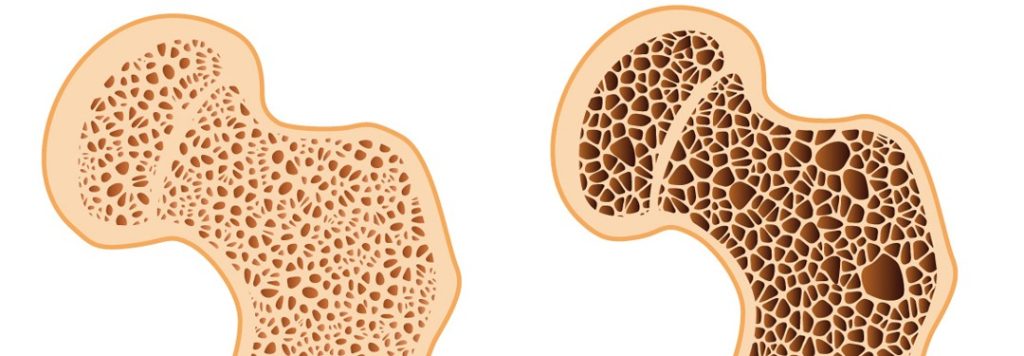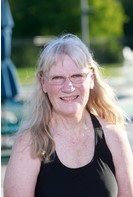
Osteoporosis is a disease characterized by loss of bone mass. The image on the left illustrates normal bone and the image on the right illustrates osteoporosis. A loss of bone mass increases the risk of fractures. Osteoporosis affects more than 10 million adults in the United States. The lifetime risk for a fracture due to osteoporosis is 40-50% for women and 13-22% for men. It used to be thought that osteoporosis is a normal part of aging, but it is now understood to be preventable and treatable. The strategies to reduce fracture risk include adequate combined intake of calcium and vitamin D, medications, weight bearing and/or resistance exercise, avoiding tobacco use, moderate alcohol use, and reducing the risk of falls.
The kind of weight bearing exercise recommended by the Bone Health and Osteoporosis Foundation (BHOF) includes high impact exercise such as tennis, running and jumping rope, and low impact exercise such as using an elliptical machine and fast walking. The kind of resistance exercise recommended includes using free weights, elastic bands or body weight. Water exercise is not listed among the recommended exercise. The buoyancy of water seems to be responsible for the idea that exercise in water has no impact and therefore is not beneficial for the prevention or management of osteoporosis. Research on water exercise and osteoporosis has been ongoing since the 1990’s and the evidence increasingly shows that water exercise can indeed be included in the toolbox. Nineteen studies were referenced in an article written by Flavia Yazigi PhD and Mushi Harushi MS entitled “Aquatic Exercise Against Osteoporosis.” It appeared originally in Akwa magazine published by the Aquatic Exercise Association (AEA) in April/May 2016; it was updated in 2019. AEA published four articles on the latest research in various issues of Akwa magazine in 2021. To read the articles you have to be a member of AEA. To join, click on the link to their website and then you can access past issues of Akwa. Below is a sampling of the findings written up in these articles.
Kimberly Huff, MS in her article “HIT It Before You Break It” in the April/May 2021 issue of Akwa, notes that the strength of bone tissue is dependent on the amount of stress placed on the bones. Muscles are attached to bones, so the more forceful the muscle contraction, the more stress on the bones. A combination of high impact training and high intensity resistance training has the greatest effect on bone density, as noted by the BHOF. A combination of high impact aquatic jump training, such as vertical and lateral jumps, tuck jumps and ankle hops, or high intensity interval training (HIIT) in which participants worked at near maximal effort, plus high intensity resistance training performed in water showed improvements in bone density and muscular strength and power nearly as effective as land-based training. Maximal effort was determined using either perceived exertion or by requiring participants to keep pace with a set cadence. Information on aquatic exercises to use for interval training and how to progress them to high intensity is available in my book Water Fitness Progressions. Resistance training should focus on the hip, spine and forearm as those are the areas of the body most susceptible to fractures. Squats, lunges, leg extensions, leg curls, hip extensions, chest presses, shoulder presses, biceps curls and triceps extensions address these areas.
Flavia Yazigi PhD lead a study (Yazigi at al., 2019) that looked at deep water exercise and found that it offers benefits to individuals with osteoporosis when the workout is based on aerobic and resistance exercises. The entire body, except for the head, is subjected to constant hydrostatic pressure in deep water. Water resistance acts in the opposite direction of body motion, therefore greater muscle activity is required. Muscular strengthening is enhanced, particularly when near maximal effort is exerted.
Eduardo Netto, MS, in his article “Osteoporosis – Can Exercise Help?” in the June/July 2021 Issue of Akwa, points out that there is no one specific exercise protocol suitable for everyone. Young or healthy people may engage in activities with high loads such as tennis, running and jumping rope, but older people may need to increase their level of exercise with activities with less impact, such as walking, complemented with resistance exercise using free weights. Since aquatic exercise has presented numerous benefits for the maintenance and prevention of osteoporosis, individuals have the option of choosing the exercise mode that most appeals to them. Interestingly, several studies have observed higher participation in aquatic exercise compared to land-based exercise. The best exercise is, of course, the one you do frequently.
Alex Mong, a student at West Virginia University studying exercise physiology, in his article “Balance Is Key: Aquatic Exercise to Improve Bone Mineral Density” in the June/July 2021 issue of Akwa, points out that falls which can lead to fractures are an issue for people with osteoporosis. According to the National Council on Aging, 1 in 4 Americans over the age of 65 falls each year. Improving balance is the most important thing that can be done to reduce the risk of falling. However, once someone has fallen and broken a bone, they often become inactive out of fear of falling again. Exercise in water reduces the risk of injury from falling while exercising. It also helps with balance because the buoyancy and viscosity of water makes participants who are afraid of falling feel more secure. There are many exercises that can be done in water to improve balance, such as gait training, hip and trunk stabilization, muscular strengthening, exercises focusing on the ankles, and unpredictable commands to improve reaction time.
Brianna Martinez, BS, Eric Leslie, MS, and Len Kravitz, PhD wrote “Exercise for Bone Health: What Can Aquatic Exercise Do?” in the December 2021/January 2022 issue of Akwa. They summarized nine research studies done in the past decade on osteoporosis and water exercise. The authors conclude that research shows water exercise improves bone mineral density, which makes aquatic exercise an exciting alternative to traditional resistance training and land-based exercise for bone health.
The Bone Health and Osteoporosis Foundation may not have any information on water exercise on their website, but they have a lot of additional information about osteoporosis for both healthcare providers and patients. Click on the link to check it out. There are also support groups for people with osteoporosis. Bone Buddies is a free support group that meets on the second Saturday of each month on Zoom at 10:00 AM Central Standard Time. To attend a meeting, go to https://us02web.zoom.us/j/83301196518 The meeting ID is 833 0119 6518. The Passcode is Unity. For more information, you can contact the facilitator, Elaine Henderson, at esenderson214@gmail.com
See you in the pool!

